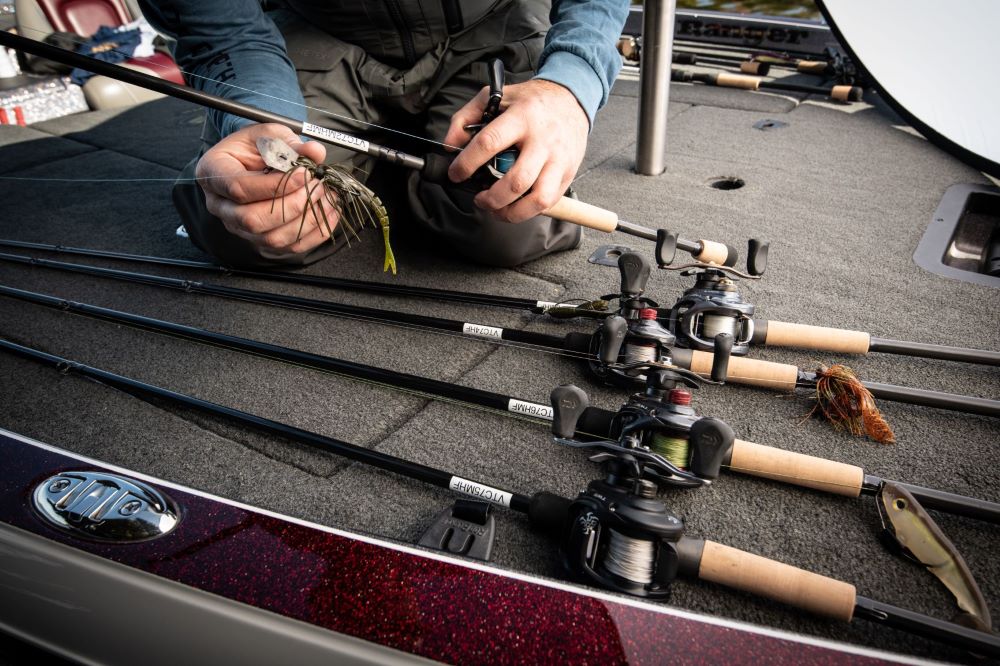How It’s Made
Testing the Best Rods on Earth
April 17, 2023

St. Croix delivers the Best Rods on Earth by combining angler-driven research and development, industry-leading design an innovation gained from 75 years of experience, the highest-quality materials, passionate and precise craftsmanship from people who care, and the most advanced rod-manufacturing facilities in the world. All of these things contribute to the pride and satisfaction you feel when you fish one of our rods, but we never assume that’s enough.
Every distinct rod model St. Croix offers is extensively tested at multiple stages to ensure it will perform as designed, ultimately, giving you the angler the upper hand when you put it to the final test on the water.
“There are several steps our blanks and rods go through with respect to testing,” says St. Croix Vice President of Research and Development, Jason Brunner. “When we create a new model, the first thing we do is test the blank through production. Many of our blanks have multiple patterns. If they are too wide or stack up incorrectly, it can cause a variety of problems. We scrutinize the first-off prototypes to make sure the patterns are properly nested and rolled to provide optimum performance, making adjustments if necessary. We’re looking for a finished blank that is visually perfect with no wrinkles or inconsistencies. All of this takes place before the blank is even flexed.”
The second test is profiling the blank with what Brunner calls “the St. Croix System”. “There are a variety of steps and protocols here, but we’re basically quantifying and confirming the blank’s power and action,” Brunner says. “We deflect the blank against a specialized profiling board with a specific amount of weight at the tip. We get a load-cell reading in pounds, then multiply that by a blank distance factor to calculate what scientists would call a ‘moment of force’. In other words, we calculate the torque an angler would feel in their hand with the rod under a standard load… anywhere from a pound or so for an ultralight model to well over 10 pounds for a heavy power blank. We can compare the measured moment of force with our specifications and historical data to make sure it’s appropriate for the blank’s length, power, and action. If the numbers are out of range, we make appropriate adjustments to the blank’s design and layup.”
Once a blank is tested through production and profiled, it’s tested for strength and durability on St. Croix’s proprietary Dynamic Analyzer. “Our Dynamic Analyzer is a sophisticated piece of equipment that precisely deflects a blank a given number of times to a realistic, measured level,” Brunner says. “It mimics the forces the finished rod will see on the water to ensure performance and durability.” But the strength testing doesn’t end there. Similar to Ian St. Ian’s special amplifier in the movie This is Spinal Tap, Brunner ‘takes it up to 11’ by repeatedly deflecting the blank on the Dynamic Analyzer at up to 25% more force. “If there is no failure, the rod is valid,” says Brunner, noting that they also cycle every blank until it eventually breaks – if, that is, they can get it to break.

While the “dynamics” in Dynamic Analyzer refers to the study of bodies in motion, St. Croix’s Static Analyzer – another piece of sophisticated testing equipment unique to St. Croix – tests blanks and finished rods at rest. “Our Static Analyzer tests and quantifies sensitivity,” says Brunner. “It captures the amount of energy loss in a blank. We hang a blank in the Static Analyzer and introduce a quantifiable amount of energy via an impulse hammer at the tip. An accelerometer then records the corresponding amount of energy received at the butt end of the blank. We have standards that are acceptable for energy loss for a given category of blank or finished rod that we make, so this test allows us to quantify any blank’s sensitivity and compare it to those standards.”

While laboratory testing is critically important to delivering anglers the Best Rods on Earth, so is field testing. “Just because a new rod model passes testing at the factory, it doesn’t mean it’s ready to give our anglers the upper hand,” says St. Croix Brand Manager, Ryan Teach, who amidst all his other duties, also spearheads St. Croix’s field testing program.
By the time most rods actually get to the field-testing stage, Teach says the Engineering and Product Teams have already made an average of ten revisions to the blank as a result of the previously described laboratory testing. “Those revisions are made in order to get the rod as close to perfect as it can be in the controlled environment of the lab,” he says. “Field testing verifies real-world performance.”
Teach says his team identifies the right group of field testers for each new series St. Croix designs and crafts. “In addition to having the ability to be on the water at lot, these anglers must be incredibly communicative and honest,” he says. “We need them to fish the rods in the manner they were designed to be fished, then have the experience and ability necessary to communicate every pro and con.”
Teach says you can field test all you want, but what’s done with the info that comes back is what really matters. “Some rod models pass after the first round of feedback comes in,” he says, “but most are tweaked and retested… sometimes repeatedly,” says Teach, noting that recent field testing of certain SEAGE Surf models and RIFT Salt and Rift Jig models resulted in up to six revisions. “Field testing verifies how our rods perform in real-world conditions, so we’re not done until we’ve addressed every concern and detail. We’re not just looking for feedback on how a rod casts, feels, and performs while fishing, but also how it performs while being stored, transported, cleaned and more. By the time this process is completed, and a new St. Croix rod finally hits the market, it is verified to give the anglers the upper hand.”

As advanced as St. Croix’s current testing capabilities are, Brunner and Teach want anglers to know that the R&D Team – like the rest of the company – is never sitting still. “We’re in the process of building an all-new Research and Development laboratory that will take our product testing capabilities to all new levels,” he says. “We plan to be fully operational by June 5, and will announce more details after that time.”

